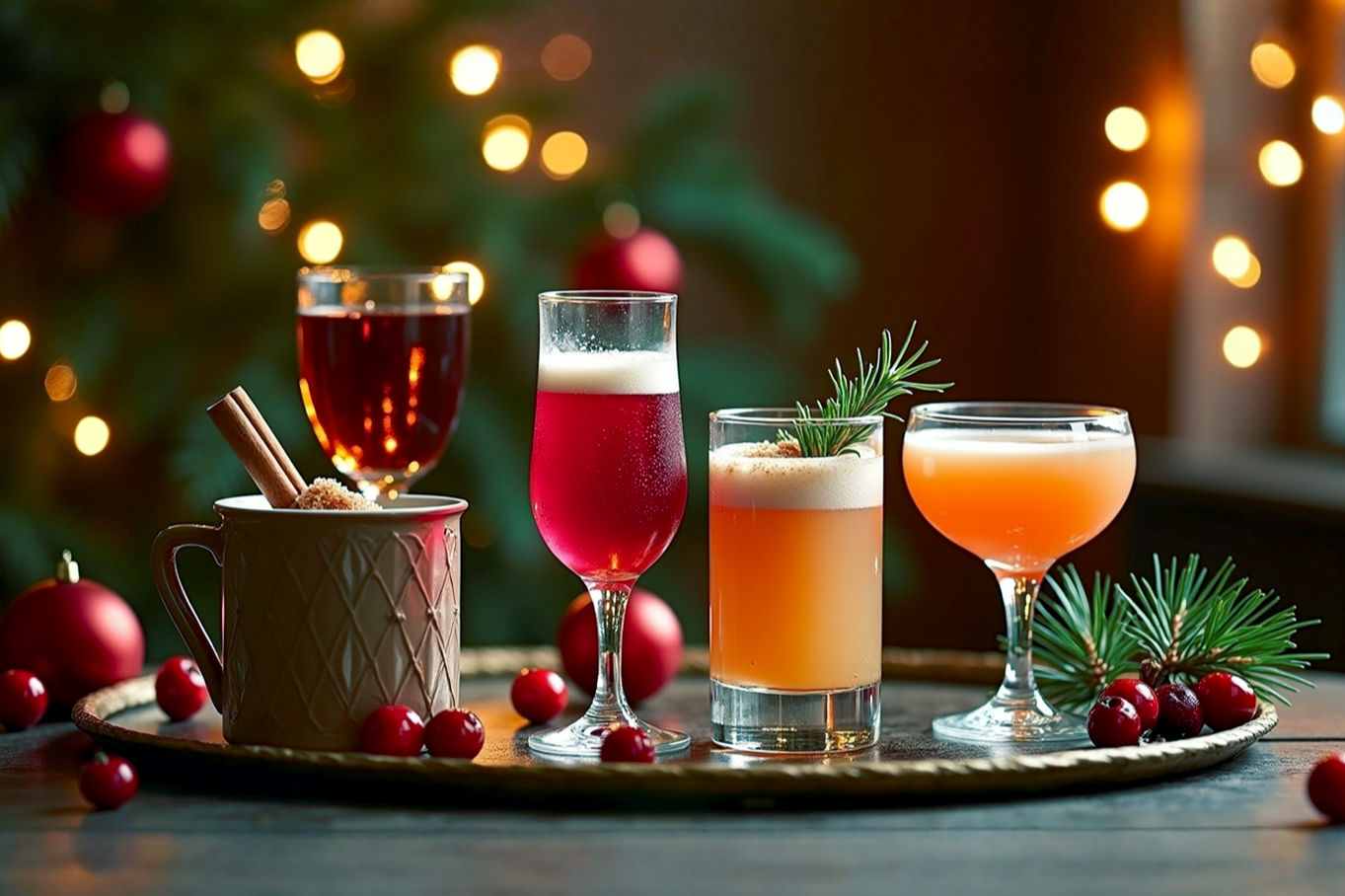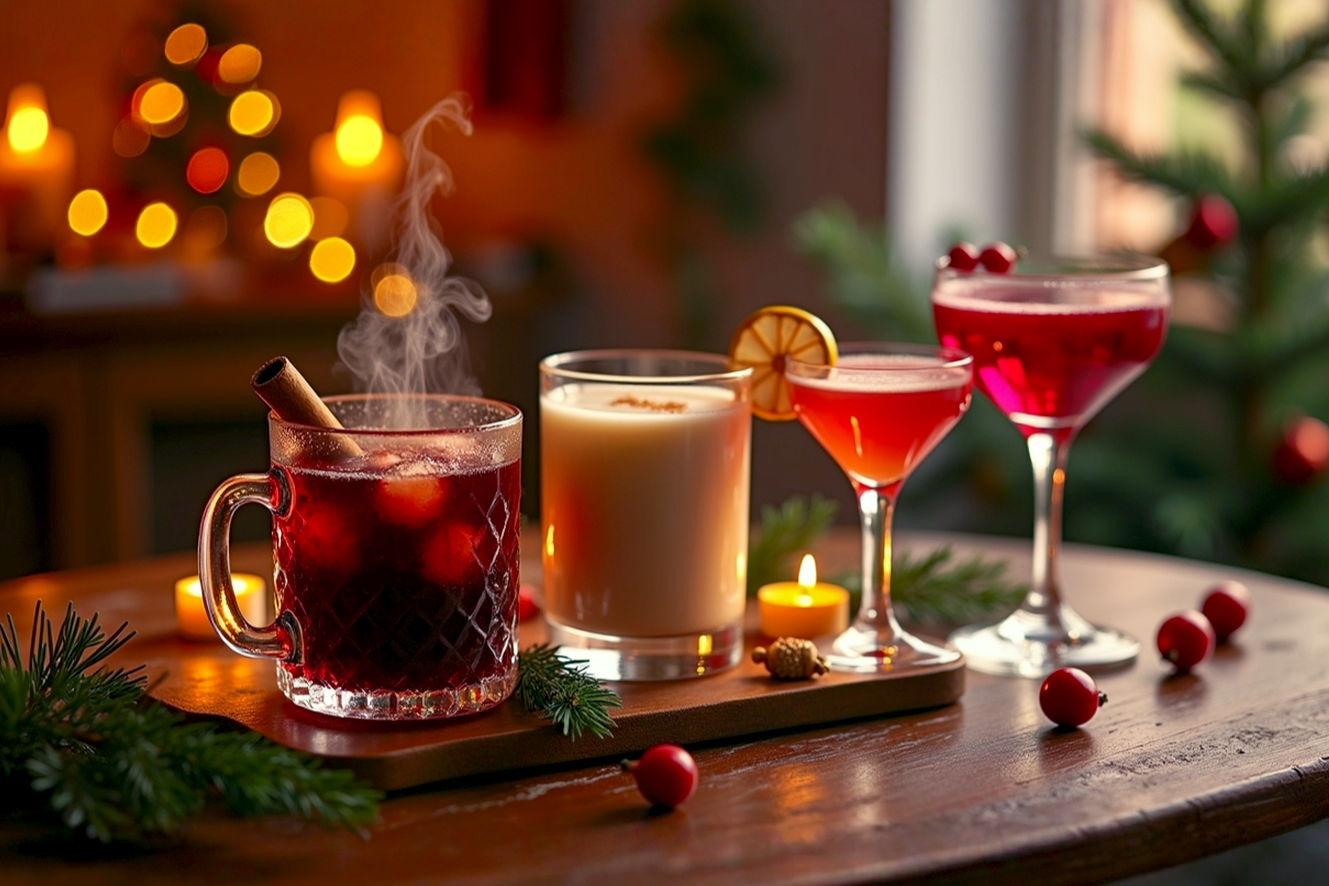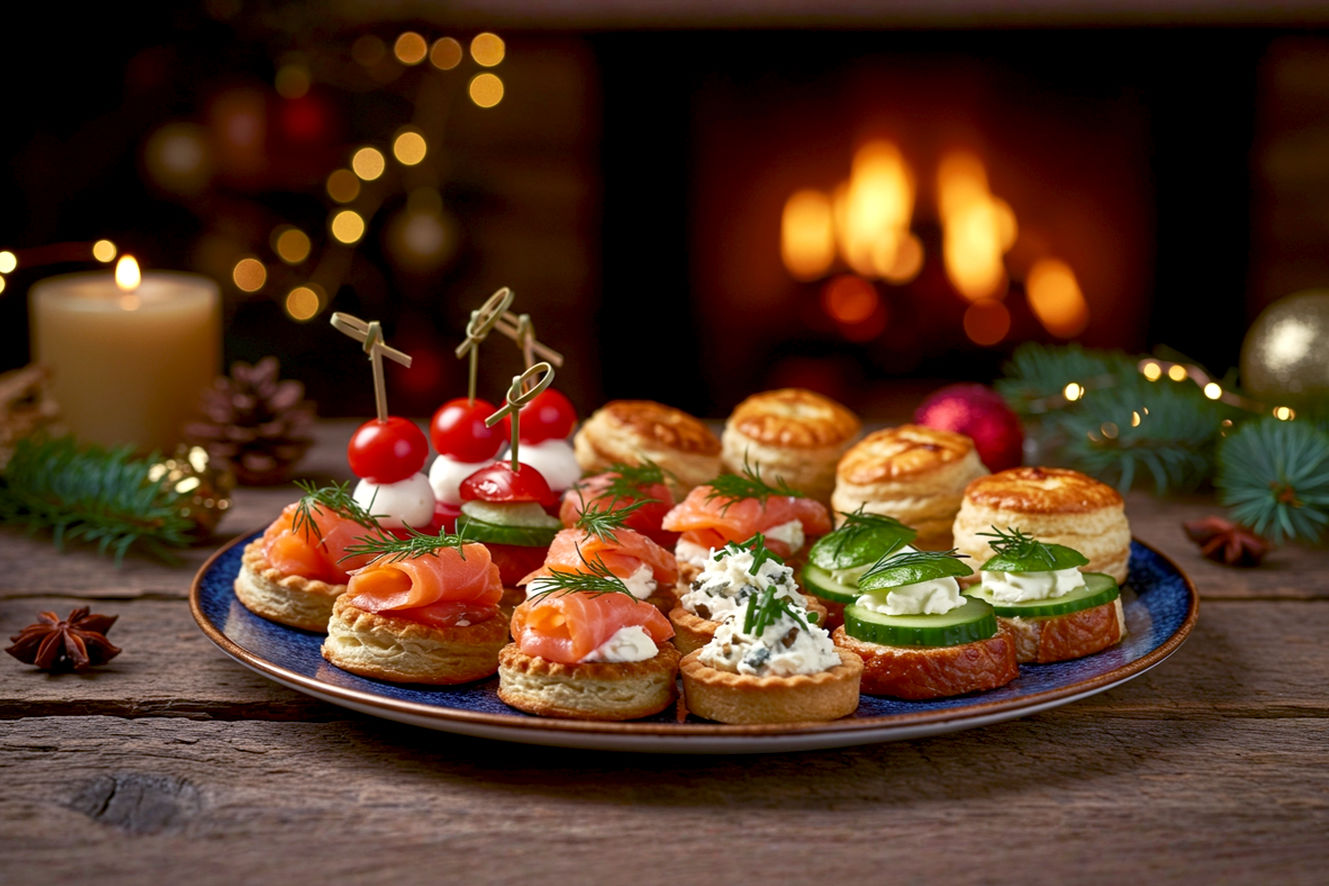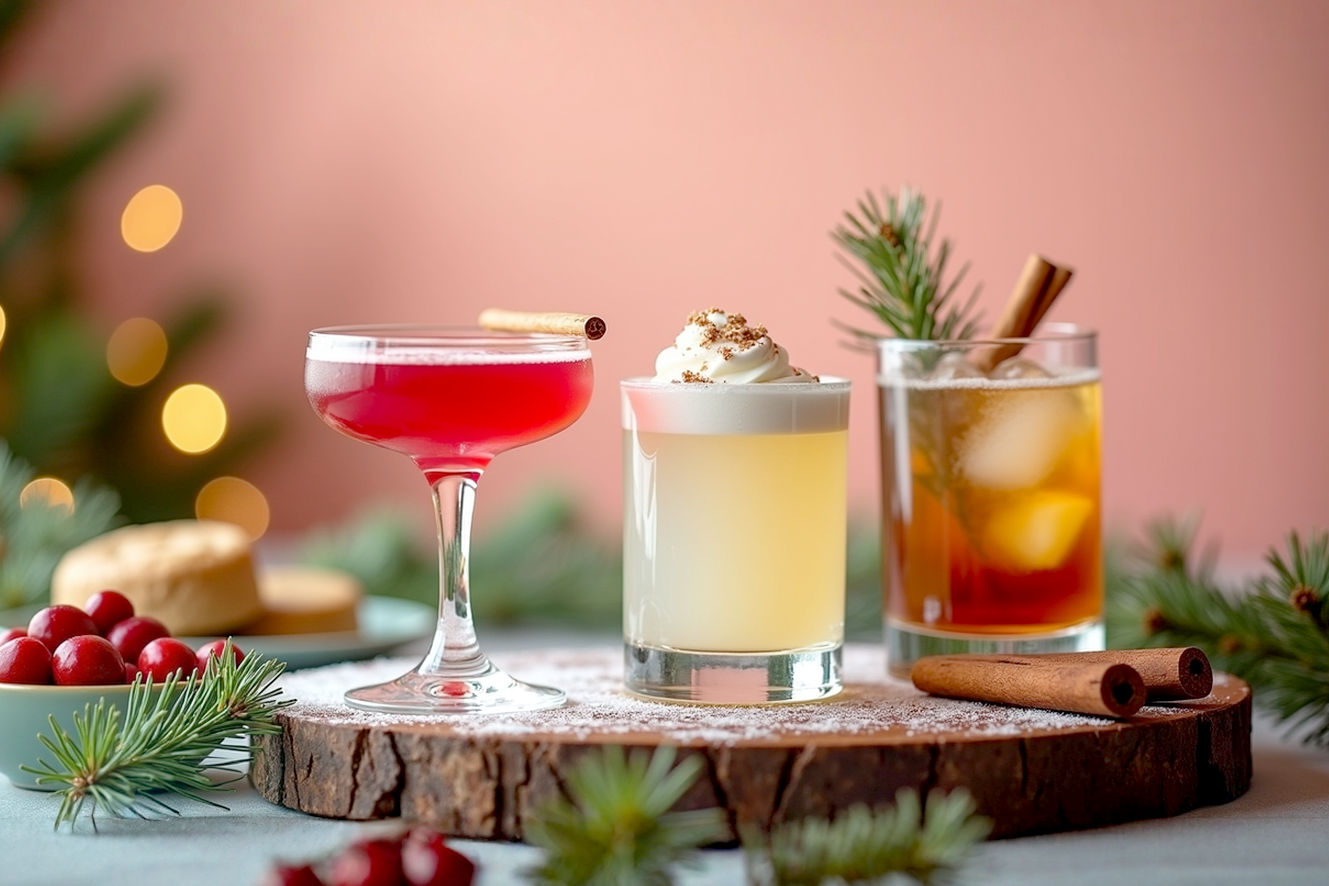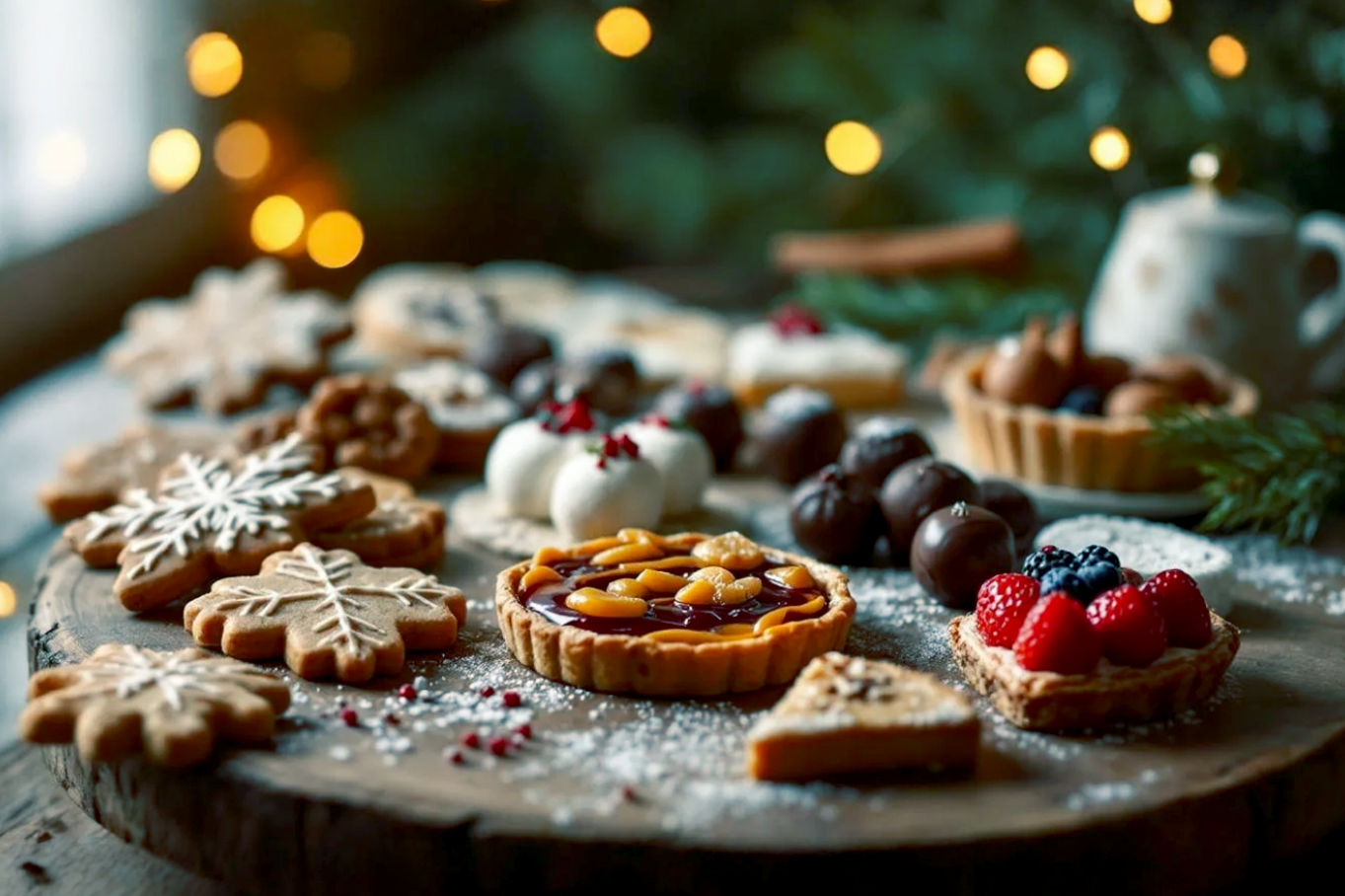This post may contain affiliate links. If you make a purchase through these links, we may earn a commission at no additional cost to you.
The holiday season is a time for sharing joy, warmth, and thoughtful presents. While store-bought gifts are convenient, there’s something truly special about a homemade Christmas food gift. These edible presents aren’t just delicious; they carry a personal touch that shows you put time, effort, and love into creating something unique for your friends and family. This guide will help you discover the magic of DIY food gifts for Christmas, offering a wealth of creative ideas, practical tips, and detailed instructions to make your holiday gifting both memorable and delicious.
The Heartfelt Appeal of Homemade Edible Gifts
Why do we love receiving a batch of homemade holiday treats or a beautifully packaged jar of jam? It’s more than just the taste. It’s the thought, the effort, and the personal connection. When you choose to make DIY food gifts, you’re not just giving an item; you’re sharing a piece of your kitchen, your time, and your creativity.
Why DIY Food Gifts?
The appeal of homemade Christmas food gifts is multi-faceted. First, they offer a personal touch that mass-produced items simply can’t replicate. Each cookie, every jar of spiced nuts, or bottle of infused oil carries the unique signature of its maker. This makes the gift feel more intimate and cherished. Second, they can be incredibly cost-effective. While high-quality ingredients are important, making gifts in batches often proves more economical than buying individual presents for everyone on your list. You can leverage bulk buying discounts and seasonal produce to keep expenses down. Finally, edible Christmas gifts are wonderfully unique. You can tailor flavors, ingredients, and presentation to perfectly suit the recipient’s tastes, ensuring they receive something they truly love and appreciate.
The Joy of Giving and Receiving
There’s a special joy that comes from presenting someone with a gift you’ve crafted yourself. Seeing their face light up as they realize the effort involved is incredibly rewarding. For the recipient, it’s a delightful surprise to receive something so thoughtfully prepared, often evoking feelings of nostalgia or comfort. These gifts often spark conversations, sharing of recipes, and create lasting memories around the holiday table.
Benefits of Edible Gifts
Beyond the personal connection, DIY food gifts offer practical benefits. They are consumable, meaning they won’t add clutter to someone’s home. In an age where many people are trying to minimize possessions, a delicious treat that can be enjoyed and shared is often more welcome than another trinket. This also means less waste in the long run. Furthermore, they are inherently thoughtful. The act of choosing a recipe, sourcing ingredients, and carefully preparing the item speaks volumes about your care for the recipient. It’s a gift that nourishes both the body and the spirit.
Planning Your DIY Christmas Food Gift Strategy
Successful homemade Christmas food gifts don’t just happen; they’re the result of careful planning. Before you start baking or bottling, consider these key aspects to ensure a smooth and enjoyable gifting process.
Setting Your Budget and Timeframe
Even though DIY food gifts can be cost-effective, it’s wise to set a budget. Think about how much you want to spend per gift or overall. This will help guide your recipe choices and ingredient sourcing.
Cost-effectiveness explained: Making food gifts in bulk significantly reduces the per-unit cost compared to buying individual gourmet items. For example, a large bag of flour, sugar, and chocolate chips can yield dozens of cookies for a fraction of the price of buying pre-made cookie boxes. Consider ingredients that are on sale or in season.
Batch cooking and efficiency: To maximize your time and effort, embrace batch cooking. This involves making large quantities of one item at a time. For instance, if you’re making cookies, bake several batches at once. If you’re preparing a spice mix, blend a large amount and then divide it into smaller containers. This approach streamlines the process, saves energy, and reduces clean-up time.
Making ahead: Shelf life considerations: Many homemade holiday treats can be made weeks or even months in advance. This is a huge advantage during the busy holiday season. Items like jams, certain types of candy, and dry mixes in a jar have a long shelf life. Baked goods often freeze well. Always consider the shelf life of your chosen recipes and plan your production schedule accordingly. This allows you to spread out the work and avoid last-minute stress.
Who Are You Gifting To?
Tailoring your edible Christmas gifts to the recipients makes them even more special.
Dietary restrictions and preferences: This is a crucial consideration. Does anyone on your list have allergies (nuts, dairy, gluten)? Are they vegan, vegetarian, or do they avoid certain ingredients? Offering gluten-free cookies, dairy-free fudge, or nut-free granola ensures everyone can enjoy your gift safely. It shows you truly thought about their needs. Always clearly label ingredients on your gift tags, especially if potential allergens are present.
Sweet vs. Savory preferences: While many people love sweet treats, some prefer savory options. Balance your gift list with both. Perhaps a sweet hot chocolate mix for one friend and a savory infused olive oil for another. This variety ensures your gifts cater to a broader range of tastes.
Personalized touches for recipients: Beyond dietary needs, think about what each person genuinely enjoys. Do they love coffee? A homemade coffee liqueur or a gourmet coffee blend might be perfect. Are they a baker? A unique baking mix in a jar could be ideal. A handwritten note mentioning why you chose that particular gift for them adds another layer of thoughtfulness.
Sourcing Ingredients: Quality Matters
The quality of your ingredients directly impacts the taste and appeal of your DIY food gifts.
Local and seasonal ingredients: Whenever possible, opt for local and seasonal produce. Not only does it often taste better, but it supports local farmers and can be more sustainable. Fresh, in-season fruits for jams or herbs for infused oils will elevate your gifts.
Bulk buying for savings: For staples like flour, sugar, nuts, and chocolate, buying in bulk can significantly reduce costs. Many grocery stores and specialty food shops offer bulk bins. Just be sure to store bulk ingredients properly to maintain freshness.
Specialty ingredients for gourmet gifts: Don’t shy away from specialty ingredients if they enhance your gift. A high-quality vanilla bean for vanilla extract, artisanal cocoa powder for truffles, or unique spices for a custom blend can transform a simple gift into a gourmet experience. Explain any unique ingredients on your gift tag for the recipient.
Sweet Sensations: Irresistible Homemade Treats
When it comes to homemade Christmas food gifts, sweet treats are often the first thing that comes to mind. They’re comforting, festive, and universally loved. Here are some ideas to inspire your holiday baking and candy-making.
Classic Baked Goods with a Twist
Baked goods are a staple of edible Christmas gifts. With a little creativity, you can elevate traditional recipes into something truly special.
Festive Cookies & Bars
Cookies and bars are perfect for gifting because they’re often easy to make in large batches and transport well.
- Gingerbread Cookies: These classic holiday cookies are a must-have. You can make traditional crisp gingerbread people decorated with royal icing, or try a softer, chewier version. For a twist, consider gingerbread sandwich cookies filled with cream cheese frosting, or gingerbread biscotti for dipping in coffee. The key to great gingerbread is a balanced spice blend, typically including ground ginger, cinnamon, cloves, and nutmeg.
- Peppermint Bark: This is a surprisingly easy yet impressive treat. It involves layering melted chocolate (often dark or semi-sweet) with white chocolate, then sprinkling crushed candy canes on top. The “technical” aspect here is tempering the chocolate, which helps it set with a glossy finish and prevents blooming (white streaks). However, for home gifting, simply melting good quality chocolate gently (over a double boiler or in the microwave at short intervals) and allowing it to set in the refrigerator works perfectly well. Ensure your candy canes are finely crushed for even distribution.
- Holiday Biscotti: These twice-baked Italian cookies are wonderfully crunchy and keep well, making them ideal for gifting. Infuse them with holiday flavors like cranberry-pistachio, orange-almond, or even a spiced eggnog variation. They’re perfect for dipping in coffee, tea, or even a glass of dessert wine. The double-baking process removes moisture, giving them their characteristic crisp texture and extended shelf life.
- Millionaire’s Shortbread: This decadent bar features three glorious layers: a buttery shortbread base, a rich, chewy caramel filling, and a smooth chocolate topping. The challenge lies in achieving the perfect caramel consistency – it needs to be firm enough to hold its shape but soft enough to bite through. Using a candy thermometer to reach the correct temperature (around 245°F or 118°C for soft ball stage) is a technical detail that ensures success. The chocolate layer can be tempered for a professional finish or simply melted and spread.
Decadent Candies & Confections
Homemade candies add a touch of luxury to your Christmas gift baskets food.
- Homemade Fudge: Fudge is a beloved holiday treat that comes in countless flavors. Classic chocolate fudge is always a hit, but don’t stop there. Peanut butter fudge, white chocolate cranberry, or even a unique maple-walnut fudge can be delightful. The science behind fudge involves sugar crystallization; precise temperature control (often using a candy thermometer to reach 234-237°F or 112-114°C, the soft ball stage) and careful stirring are crucial for a smooth, creamy texture, preventing it from becoming grainy.
- Salted Caramels: These chewy, buttery caramels with a sprinkle of flaky sea salt are incredibly addictive. Making caramel requires careful attention to temperature to prevent burning and achieve the right consistency. A candy thermometer is highly recommended. The addition of a high-quality sea salt, like Maldon or fleur de sel, balances the sweetness and adds a pleasant textural contrast.
- Chocolate Truffles: Elegant and rich, chocolate truffles are surprisingly simple to make. They typically consist of a ganache (a mixture of chocolate and cream) rolled into balls and coated in cocoa powder, chopped nuts, or sprinkles. The ratio of chocolate to cream determines the ganache’s firmness, affecting how easily it can be rolled. A higher chocolate content yields a firmer truffle. Experiment with flavorings like liqueurs, extracts (peppermint, orange), or spices (cinnamon, chili).
- Candied Nuts: Sweet and crunchy, candied nuts are a versatile edible Christmas gift. You can make spiced pecans, sugared almonds, or glazed walnuts. The process usually involves tossing nuts with a sugar syrup or egg white mixture and then baking them until crisp. For spiced nuts, incorporate warming spices like cinnamon, nutmeg, cloves, and a hint of cayenne pepper for a sweet-and-spicy kick. The coating should be thin and even to prevent clumping.
Jars of Delight: Mixes and Preserves
Food gifts in a jar are incredibly popular because they’re visually appealing, easy to assemble, and often have a long shelf life. They also allow the recipient to enjoy the “making” process themselves.
Hot Chocolate Mixes in a Jar
A layered hot chocolate mix in a jar is both beautiful and comforting.
- Layering ingredients: The visual appeal comes from carefully layering dry ingredients like cocoa powder, granulated sugar, powdered milk, mini marshmallows, and chocolate chips (mini or chopped). You can also add crushed candy canes, cinnamon sticks, or a few chocolate-covered espresso beans for extra flair.
- Gourmet variations: Elevate the classic with gourmet touches. Consider a peppermint hot chocolate mix with crushed candy canes, a Mexican hot chocolate mix with a pinch of chili powder and cinnamon, or a salted caramel version with caramel bits.
- Instructions tag for recipients: Don’t forget to include a small tag with clear instructions on how to prepare the hot chocolate. For example: “Combine contents of jar with 6 cups of hot milk or water. Whisk until smooth and enjoy!”
Homemade Jams & Preserves
If you enjoy canning, homemade jams and preserves make exquisite unique food gifts Christmas.
- Festive fruit combinations: Think beyond basic strawberry jam. For Christmas, consider combinations like cranberry-orange marmalade, spiced apple butter, or fig and balsamic jam. These flavors evoke the holiday spirit.
- Canning basics: For shelf-stable jams, proper canning techniques are essential. This involves sterilizing jars, filling them properly, and processing them in a boiling water bath to create a vacuum seal. This “technical” process ensures the jam is safe for long-term storage at room temperature.
- Quick refrigerator jams: If you’re new to canning or prefer a simpler method, quick refrigerator jams are a great alternative. These don’t require water bath processing and are stored in the refrigerator, typically lasting for a few weeks. They’re perfect for local gifting.
Baking Mixes in a Jar
These popular food gifts in a jar provide all the dry ingredients for a delicious baked good, requiring the recipient to add only a few wet ingredients.
- Cookie Mixes: Layer the dry ingredients for classic cookies like chocolate chip, oatmeal raisin, or sugar cookies. Flour, sugar (brown and white), baking soda, salt, and chocolate chips or dried fruit are common components.
- Brownie Mixes: Create a mix for fudgy or cakey brownies by layering flour, cocoa powder, sugar, baking powder, and salt. You can also add chocolate chunks or nuts.
- Pancake/Waffle Mixes: A homemade pancake or waffle mix, perhaps with whole grain flour and dried fruit, makes for a delightful breakfast gift.
- Layering and recipe card inclusion: Arrange the ingredients in distinct layers for visual appeal. Most importantly, attach a clear recipe card that lists the wet ingredients the recipient needs to add (e.g., eggs, butter, milk) and step-by-step baking instructions. This ensures they can easily recreate your delicious treat.
Savory Surprises: Unique Edible Gifts
While sweet treats are popular, savory food gifts Christmas offer a refreshing alternative and are often appreciated by those who prefer less sugar. These options can be incredibly gourmet and versatile.
Flavorful Spreads & Dips
Elevate everyday meals with homemade infused products or rich, savory spreads.
Infused Oils & Vinegars
These make elegant and practical gifts for any home cook.
- Herb-infused olive oil: Create aromatic oils by infusing good quality extra virgin olive oil with dried herbs like rosemary, thyme, oregano, or bay leaves. You can also add dried chili flakes for a spicy kick.
- Citrus-infused vinegar: White wine vinegar or apple cider vinegar can be infused with citrus zest (lemon, orange, lime) for a bright, flavorful addition to dressings and marinades.
- Safety considerations (botulism risk): This is a critical safety note. When infusing oils with fresh ingredients like garlic, fresh herbs, or fresh chili peppers, there is a risk of botulism if not prepared and stored correctly. Clostridium botulinum bacteria thrive in anaerobic (oxygen-free) environments and can produce a deadly toxin. To mitigate this risk, always use dried herbs and spices for infused oils intended for gifting and storage at room temperature. If you must use fresh ingredients, the oil must be refrigerated and consumed within a few days, or the fresh ingredients should be heated in the oil and then strained out before bottling. For home gifting, sticking to dried ingredients is the safest and most recommended approach for shelf-stable infused oils. Clearly label “Refrigerate and use within X days” if fresh ingredients were used and strained.
Savory Jams & Chutneys
These unique spreads offer complex flavors that pair wonderfully with cheeses, crackers, or roasted meats.
- Bacon Jam: A rich, caramelized spread made from bacon, onions, brown sugar, and coffee or maple syrup. It’s a fantastic balance of sweet, salty, and smoky flavors. The “technical” part is slowly rendering the bacon and caramelizing the onions to build deep flavor.
- Onion Marmalade: Sweet and tangy, this spread is made by slowly caramelizing onions with vinegar, sugar, and sometimes balsamic vinegar. The long cooking time breaks down the onions’ natural sugars, creating a rich, jam-like consistency.
- Spiced Pear Chutney: A delicious accompaniment to cheese boards or roasted poultry. It combines pears with vinegar, sugar, and warming spices like ginger, cinnamon, and cloves. The balance of sweet, tart, and spicy notes is key.
Gourmet Snack Mixes & Spices
Elevate snack time with homemade versions of popular munchies or custom seasoning blends.
Artisan Nut & Pretzel Mixes
These are perfect for casual gifting and can be customized endlessly.
- Spiced Nuts: Beyond candied nuts, you can create savory spiced nuts. Toss a mix of nuts (pecans, walnuts, cashews, almonds) with olive oil, herbs (rosemary, thyme), and spices (garlic powder, onion powder, smoked paprika, cayenne). Bake them until crisp and aromatic. The oil helps the spices adhere and creates a satisfying crunch.
- Savory Snack Mixes: A homemade version of classic Chex Mix is always a hit. Combine various cereals, pretzels, nuts, and bagel chips with a seasoned butter mixture (Worcestershire sauce, garlic powder, onion powder, dried herbs) and bake until golden and crunchy. The low and slow baking process ensures even crisping.
Homemade Seasoning Blends
For the aspiring chef or grill master, a custom seasoning blend is a thoughtful and practical gift.
- Ranch Seasoning: A versatile blend of dried buttermilk powder, dried parsley, dill, chives, garlic powder, onion powder, salt, and pepper. Recipients can mix it with sour cream for a dip or sprinkle it on popcorn.
- BBQ Rubs: Craft a signature BBQ rub with a blend of brown sugar, smoked paprika, chili powder, cumin, garlic powder, onion powder, and cayenne. This is perfect for grilling enthusiasts.
- Italian Herb Blends: A simple yet essential blend of dried oregano, basil, thyme, rosemary, and marjoram. It’s perfect for seasoning pasta sauces, roasted vegetables, or homemade bread. The key is using high-quality dried herbs that retain their aroma and flavor.
Drinkable Delights: Festive Beverages
Beyond food, DIY food gifts can also include delightful homemade beverages or beverage components. These are often unique and highly appreciated.
Syrups & Cordials
Homemade syrups are incredibly versatile, perfect for adding flavor to coffee, cocktails, or desserts.
Flavored Simple Syrups
Simple syrups are easy to make and offer a concentrated burst of flavor.
- Gingerbread Syrup: A warming syrup made with water, sugar, fresh ginger, cinnamon sticks, cloves, and star anise. It’s perfect for flavoring lattes, cocktails, or drizzling over pancakes. The “technical” aspect is simmering the spices to extract their flavors without over-reducing the syrup.
- Vanilla Bean Syrup: Made by infusing simple syrup with a split vanilla bean. This elegant syrup is wonderful in coffee, over fruit, or in baked goods. Using a whole vanilla bean provides a much deeper, more complex vanilla flavor than extract.
- Berry Syrups: During berry season, you can make vibrant syrups from fresh or frozen berries. These are great for cocktails, sparkling water, or as a topping for ice cream.
Homemade Liqueurs (if applicable and legal/appropriate for audience)
For adult recipients, a homemade liqueur can be a truly impressive gift.
- Limoncello: A bright, zesty Italian lemon liqueur made by infusing high-proof alcohol with lemon zest, then sweetening it with a simple syrup. The key is to use only the zest (the yellow part of the peel) and avoid the bitter white pith. The infusion process extracts the essential oils from the lemon.
- Coffee Liqueur: Combine cold brew coffee concentrate with vodka or rum and a simple syrup. This makes a rich, flavorful liqueur perfect for espresso martinis or sipping neat.
- Disclaimer on alcohol content and legal age: It is crucial to include a clear disclaimer if you are gifting alcoholic beverages. Ensure the recipient is of legal drinking age in their jurisdiction. Also, be aware of any local laws regarding homemade alcohol production and gifting. For general purposes, it’s often safer to stick to non-alcoholic syrups or mixes.
Tea & Coffee Blends
For the hot beverage enthusiast, custom tea or coffee blends make for comforting and aromatic gifts.
Spiced Tea Blends
Create your own fragrant tea blends for a cozy holiday experience.
- Mulling Spices: A classic blend of whole spices like cinnamon sticks, cloves, star anise, dried orange peel, and sometimes dried ginger. These are meant to be simmered with cider or wine to create a warm, aromatic beverage. Package them in small muslin bags or clear jars.
- Chai Tea Mix: Combine black tea leaves with a blend of warming spices such as cardamom pods, cinnamon, ginger, cloves, and black peppercorns. The recipient can then brew it with milk and sugar for a traditional chai latte.
Gourmet Coffee Beans
Elevate a coffee lover’s daily ritual with specially prepared beans.
- Infused Coffee Beans: You can subtly infuse whole coffee beans with flavors like vanilla (by storing them with a vanilla bean) or cinnamon (with cinnamon sticks). The beans will absorb the aroma over time.
- Small-batch roasted beans: If you have access to green coffee beans and a home roaster, small-batch roasted beans are a truly unique gift. Otherwise, source high-quality beans from a local roaster and package them beautifully.
Packaging Perfection: Presenting Your Edible Masterpieces
The presentation of your DIY food gifts is almost as important as the food itself. Beautiful packaging elevates your homemade treats from simple gestures to truly special presents.
Choosing the Right Containers
The container you choose should protect the food, enhance its visual appeal, and ideally be reusable.
- Jars: Mason jars are incredibly versatile and popular for food gifts in a jar. They come in various sizes and are perfect for mixes, jams, infused oils, and even layered desserts. Swing-top bottles are excellent for liquids like syrups or liqueurs. Jars provide an airtight seal, crucial for freshness.
- Tins & Boxes: Decorative cookie tins are classic for baked goods. Bakery boxes with clear windows allow the recipient to see the delicious contents. Small cardboard boxes, perhaps lined with parchment paper, are great for individual candies or truffles.
- Cellophane Bags & Pouches: These transparent bags are ideal for displaying individual cookies, candies, or snack mixes. They can be tied with festive ribbons. For items that need to stay fresh, ensure they are food-safe and provide a good seal.
- Eco-friendly options: Consider using reusable containers that the recipient can repurpose, like glass jars, decorative tins, or even small ceramic dishes. You can also opt for recycled paper boxes or compostable cellophane bags to minimize environmental impact.
Aesthetic Touches: Ribbons, Tags & Labels
These small details make a big difference in the overall presentation.
- Ribbons & Twine: Use festive ribbons in traditional Christmas colors (red, green, gold, silver) or natural twine for a rustic look. A simple bow can add elegance.
- Custom Labels & Gift Tags: Design and print your own labels with the gift’s name, ingredients, and any special instructions (e.g., “Keep Refrigerated”). You can find many free printable templates online, or simply use cardstock and a nice pen for handwritten notes. A personalized gift tag with a heartfelt message adds a warm touch.
- Decorative Elements: Incorporate natural elements for a charming, rustic look. A small sprig of fresh pine or cedar, a dried orange slice, a cinnamon stick, or a few whole star anise pods tied with twine can make your gift visually stunning and aromatic.
Practicality & Preservation
Beyond aesthetics, packaging needs to be functional to ensure your gifts arrive safely and stay fresh.
- Airtight Sealing: This is paramount for preserving freshness and extending shelf life. Ensure lids are tightly sealed on jars and tins, and cellophane bags are securely tied or heat-sealed. Exposure to air is the enemy of freshness for most food items.
- Cushioning & Protection: For fragile items like cookies or brittle, use tissue paper, crinkle paper, or even shredded paper to cushion them within the container. This prevents breakage during transport. For gift baskets, arrange items snugly to prevent shifting.
- Storage Instructions: Always include clear storage instructions on a tag or label. For example: “Store in an airtight container at room temperature for up to 2 weeks,” or “Refrigerate after opening.” This helps the recipient enjoy your gift at its best and ensures food safety.
Assembling Gift Baskets & Boxes
For a more substantial gift, combine several homemade items into a themed basket or box.
- Themed baskets: Create a cohesive theme. Examples include:
- “Breakfast in a Basket”: Homemade pancake mix, a jar of festive jam, and a small bottle of maple syrup.
- “Movie Night Munchies”: A gourmet spiced popcorn mix, homemade chocolate bark, and a hot chocolate mix.
- “Italian Night”: A jar of homemade pasta sauce, a bottle of herb-infused olive oil, and a bag of homemade biscotti.
- Layering and arrangement for visual appeal: Start with taller or heavier items at the back or center, then layer smaller items around them. Use crinkle paper or tissue paper to fill gaps and add volume. Think about color and texture when arranging.
- Adding non-food complements: Enhance the gift by including non-food items that complement the edible treats. This could be a cute measuring spoon for a baking mix, a festive tea towel for a jam basket, a small whisk for a hot chocolate mix, or a recipe card for how to use your infused oil.
Shelf Life and Storage: Ensuring Freshness
Understanding the shelf life of your homemade Christmas food gifts is crucial for both quality and safety. Proper storage ensures your recipients enjoy your delicious creations at their peak.
General Guidelines for Different Food Types
The longevity of your edible gifts depends heavily on their ingredients and preparation.
- Baked Goods:
- Cookies and Brownies: Most cookies and brownies, when stored in an airtight container at room temperature, will stay fresh for 1 to 2 weeks. For longer storage, they can often be frozen for 1 to 3 months. Thaw them at room temperature before gifting or consuming.
- Cakes and Quick Breads: These typically last 3-5 days at room temperature in an airtight container. If they contain fresh fruit, cream cheese frosting, or dairy, they should be refrigerated and consumed within a few days. They can often be frozen for up to 2-3 months.
- Candies & Confections:
- Fudge, Caramels, and Truffles: When stored in an airtight container in a cool, dark place, these can last for several weeks (3-4 weeks). Truffles made with fresh cream may need refrigeration and have a shorter shelf life (1-2 weeks).
- Bark (e.g., Peppermint Bark): Stored airtight in a cool place, bark can last for up to 2-3 weeks.
- Mixes in a Jar (Dry Ingredients):
- These have the longest shelf life. As long as all ingredients are dry and properly sealed, they can last for 6 months to 1 year, depending on the freshness of the individual components (e.g., nuts can go rancid faster than flour).
- Jams & Preserves:
- Properly Canned and Sealed: Unopened, shelf-stable jams and preserves can last for 1 year or more in a cool, dark pantry.
- Opened or Refrigerator Jams: Once opened, or for quick refrigerator jams, they must be stored in the refrigerator and typically last for 2-4 weeks.
- Infused Oils:
- CRITICAL SAFETY: As mentioned earlier, infused oils, especially those with fresh ingredients (garlic, herbs), pose a risk of botulism. If made with dried herbs/spices only, they can be stored at room temperature for several months. However, if fresh ingredients were used and strained, the oil must be refrigerated and consumed within 3-5 days. If fresh ingredients remain in the oil, it should be discarded after a few days, even if refrigerated, as the risk is too high. Always err on the side of caution and use dried ingredients for shelf-stable infused oils for gifting. If you see any cloudiness, bubbling, or off-smells, discard immediately.
- Syrups:
- Most simple syrups, especially those with fruit or fresh spices, should be refrigerated and will last for 2-4 weeks. Syrups with high sugar content and no fresh ingredients may last longer.
- Homemade Liqueurs:
- These typically have a long shelf life due to the alcohol content, often 6 months to 1 year or more when stored in a cool, dark place. However, those with dairy or fresh fruit components may have a shorter refrigerated shelf life.
Tips for Extending Shelf Life
A few simple practices can significantly improve the longevity of your edible Christmas gifts.
- Proper cooling before packaging: Always ensure baked goods and candies are completely cooled before packaging them. Packaging warm items will create condensation, leading to sogginess and potential mold growth.
- Airtight containers: This is the golden rule for most food gifts. Oxygen exposure accelerates spoilage, staleness, and rancidity. Glass jars with tight-fitting lids, metal tins with snug covers, and heavy-duty, sealable plastic bags are excellent choices.
- Refrigeration/Freezing when appropriate: For items with dairy, fresh fruit, or those you want to prepare far in advance, refrigeration or freezing is essential. Make sure your packaging is freezer-safe if you choose this method.
- Vacuum sealing: For some items, like certain snack mixes or even individual cookies, vacuum sealing can dramatically extend freshness by removing oxygen. This is a more advanced technique but highly effective.
Important Safety Considerations
Food safety is paramount when making and gifting homemade food.
- Botulism risk with infused oils: Re-emphasizing this point: Clostridium botulinum is a serious concern with low-acid, oxygen-free environments like infused oils containing fresh garlic, herbs, or vegetables. The bacteria can produce a deadly toxin. For home gifting, it is safest to use only dried herbs and spices for infused oils that will be stored at room temperature. If fresh ingredients are used, the oil must be refrigerated and consumed within a few days, or the fresh ingredients must be heated in the oil and then strained out before bottling. Always instruct recipients to refrigerate and use quickly if fresh ingredients were involved.
- Cross-contamination for allergies: If you are making gifts for someone with a severe allergy (e.g., nut allergy, gluten allergy), ensure your workspace, utensils, and ingredients are completely free of cross-contamination. Consider making their gift first, using dedicated equipment, or opting for naturally allergen-free recipes.
- Clear labeling of ingredients: Always, always, always include a full list of ingredients on a label attached to your gift. This is crucial for recipients with allergies, dietary restrictions, or simply those who want to know what they’re eating. It also provides transparency and professionalism.
Troubleshooting and Tips for Success
Even experienced home cooks can encounter challenges when making DIY food gifts. Here are some common issues and professional tips to ensure your holiday gifting goes smoothly.
Common DIY Food Gift Challenges
Anticipating problems can help you overcome them quickly.
- Recipes not turning out: Sometimes a recipe just doesn’t work as expected. This can be due to factors like humidity affecting baked goods (especially cookies and meringues), oven calibration (your oven might run hotter or colder than the recipe assumes), or slight variations in ingredient measurements. For instance, high humidity can make cookies spread more or prevent meringues from crisping. An uncalibrated oven can lead to under-baked or over-baked results.
- Packaging issues: Spills, breakage, or items going stale can be frustrating. A jar that isn’t sealed properly can lead to a sticky mess. Fragile cookies can crumble if not cushioned adequately. The “technical” solution often involves ensuring proper sealing mechanisms (like tight jar lids or heat-sealed bags) and using appropriate cushioning materials (tissue paper, crinkle paper, bubble wrap for shipping).
- Time management during holiday rush: The holiday season is busy, and making multiple batches of gifts can feel overwhelming. Without a plan, you might find yourself scrambling at the last minute, leading to stress and potentially lower-quality gifts.
Pro Tips for a Smooth Gifting Season
With a little foresight and organization, you can make your homemade Christmas food gifts a joyous experience.
- Start early: Plan and prepare in advance: This is perhaps the most important tip. Begin planning your gifts in late autumn. Make a list of recipients, choose your recipes, and create a master shopping list. For items with long shelf lives (jams, dry mixes, some candies), start making them in November or early December. Baked goods that freeze well can be made weeks ahead and frozen. This phased approach prevents last-minute panic.
- Test recipes before batch production: Never try a new recipe for the first time when you’re making 20 batches for gifts. Always do a “test run” with a small batch first. This allows you to identify any quirks in the recipe, adjust seasonings, or fine-tune cooking times to your equipment. It’s much better to discover a problem with one batch than with twenty.
- Organize your workspace and ingredients: Before you begin a major baking or cooking session, gather all your ingredients and equipment. Measure out dry ingredients in advance. A clean, organized workspace makes the process more efficient and less stressful. This mise en place approach, borrowed from professional kitchens, ensures you have everything you need within reach.
- Involve family and friends: Making DIY food gifts can be a wonderful holiday activity. Get your family, especially children, involved in simple tasks like mixing dry ingredients, decorating cookies, or tying ribbons on packages. It turns a chore into a cherished holiday tradition and lightens your workload.
- Embrace imperfections: The charm of homemade: Remember, these are homemade gifts. They don’t need to look factory-perfect. A slightly uneven cookie or a hand-tied ribbon adds to the charm and authenticity. The beauty lies in the effort and love you put into them, not in flawless execution. Don’t stress over minor flaws; they are part of the unique character of your creative food gift ideas.
Conclusion: The Enduring Magic of Edible Presents
As the festive season approaches, the opportunity to create creative and delicious DIY food gifts for Christmas offers a truly special way to express your affection and appreciation. We’ve explored a wide array of homemade Christmas food gifts, from classic cookies and decadent candies to savory infused oils and delightful drink mixes. We’ve also delved into the art of packaging homemade gifts, ensuring your edible masterpieces are presented beautifully and safely.
The enduring magic of edible presents lies in their ability to connect people through shared flavors and thoughtful gestures. Unlike gifts that might gather dust, a homemade food gift is meant to be enjoyed, savored, and often shared, creating warm memories around the holiday table. It’s a tangible expression of care that speaks volumes.
So, this holiday season, embrace the DIY spirit. Whether you choose to bake a batch of festive cookies, craft a unique seasoning blend, or assemble a charming gift basket, the effort you put in will undoubtedly bring joy to those you cherish. These gifts are more than just food; they are a celebration of generosity, creativity, and the true spirit of Christmas. Happy gifting, and happy holidays!

